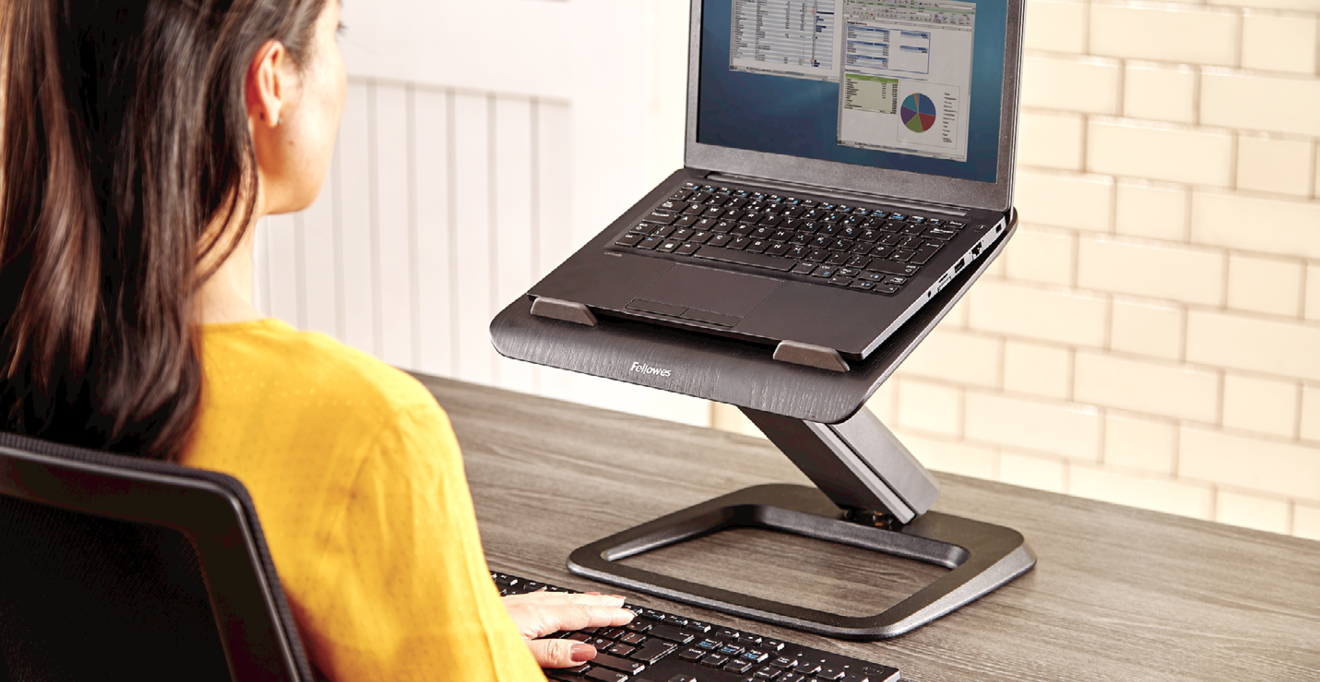Laptops are powerful, indispensable tools for the hybrid working age, but without considering laptop and desk ergonomics, you could be putting your health and productivity at risk. Here we explore why, and reveal the simple steps you need to take to avoid aches, pains and injuries.

Most of us use laptops for work, according to a 2018 report from Laptops Direct. Out of over a thousand British adults, 58% said they used a laptop as their main work device instead of a desktop computer. Today, that percentage is likely to be higher. Laptop sales boomed in 2020 as computer users scrambled for an easy way to work from home during lockdown.
For remote work, laptops have the advantage — they allow us to be adaptable in times of change and uncertainty. At the beginning of lockdown, employees already using laptops with access to cloud storage had a smoother transition from office to homeworking. All they had to do was take their laptops home with them, without needing to wait for heavy equipment to be delivered, or IT systems to be updated.
Our laptops liberate us from the confines of our desks but they also introduce health and wellbeing risks of their own. You can reduce these risks, and stay comfortable and productive, by finding the correct posture for laptop use, and forming healthy habits.
Why are laptops potentially risky?
Laptop design sacrifices good working posture for portability and convenience. Because the screen and keyboard hinge together, when you place your laptop flat on a surface and open the screen, you’ll be forced to look down to view it.
Because the viewing angle of a laptop is so low, you’ll probably find yourself sitting with your chin jutting down and forward. Your head is very heavy (about 10-12lbs) and according to research published in Surgical Technology International, the further you lean forward, the heavier the load. In a poor texting position, your head can put up to 60lbs of load on your spine, which is more than the average microwave oven.
Our ergonomist Katharine Metters says: “Using a laptop for hours on end in a poor, static position can cause or aggravate many musculoskeletal issues such as neck pain, with or without referred pain in the arm and hand, localised wrist problems - especially if using a trackpad on a laptop with a thick base. I - and my therapeutic colleagues, have also seen a rise in upper back pain, headaches, eye strain, lower back problems and even leg problems that seem to be related to poor, prolonged laptop use.”
What is the correct posture for laptop use?
Laptops are not inherently bad for us. It’s how we use them that matters. How you use your laptop can make all the difference to your health, wellbeing and productivity.
Firstly, let’s think about your posture. Sitting up straight, your eyes should be level with the top of your computer screen to avoid injury.
There are also plenty of simple workplace ergonomics tips you can try.
Set up at a desk
Laptops may be called lap-tops but using them on your lap for long stints isn’t something we’d advise. If you need to be working for more than 15-20 minutes at a time then you should set yourself up at a surface, preferably with ergonomic equipment. If all you have is your laptop then make sure you stretch and move as often as possible.
Connect your laptop to a monitor
To recreate that desktop computer experience, connect your laptop to one, two, or even three monitors to expand your workspace, multitask like a pro and improve the speed and accuracy of your work. Mount your screens on adjustable monitor arms so you can instantly tweak them to a comfortable position.
Use a laptop stand with a separate keyboard and mouse
You can purchase all three of these products in our specially selected laptop packs.
- Laptop stand - elevates your screen to eye level and keeps your device cool and protected.
- Mini keyboard - can be connected to your laptop to help you avoid typing at a steep, elevated angle when you’re using a stand.
- Ergonomic mouse - supports your hand in a healthy working posture and offers greater comfort, speed and productivity than a laptop trackpad.
Browse our collection of ergonomic mice, keyboards and laptop stands ›
Take regular breaks
While having the right equipment is crucial, you still need to take regular breaks. Even with the best set-up, you may suffer from the consequences of prolonged inactivity. This includes discomfort, stiffness, fatigue, eye strain, headaches and — in the long term without adequate exercise, increased risk of weight gain, diabetes, heart disease and premature death. Inactivity is the fourth leading cause of mortality, according to WHO. That’s why it’s so important to get up and move regularly. You can increase your opportunities for activity by using a standing desk or sit-stand desk converter. This will shake you out of sedentary postures, boost your blood and oxygen flow, activate your muscles and contribute to your overall physical activity levels. This has all been proven to keep you healthier, happier and more productive.
The key to laptop ergonomics at work (whether that’s at the office, or at home), is to invest in ergonomic accessories to make you more comfortable, and move regularly. Enjoy the portability of your laptop, explore different environments, and maintain good posture. That way, you’ll enjoy the benefits of laptops without any potential drawbacks.











